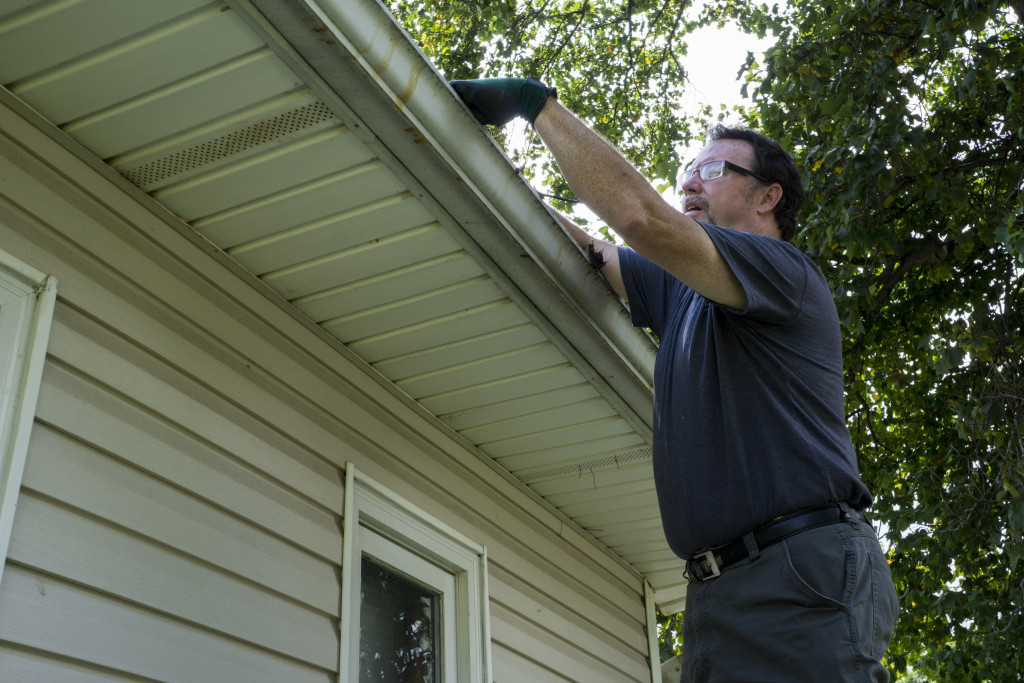It is common knowledge that the weather can be unpredictable. As a result, many homeowners take proactive steps to protect their property in inclement conditions. If you want to ensure your home and belongings are well-protected from Mother Nature’s wrath, it’s best to be knowledgeable when it comes to weatherproofing your home.
Proper weatherproofing techniques can help reduce the chances of damage caused by water and wind, ice and snow, and extreme heat or cold. You can keep your home in tip-top shape year-round by following the ideas below.

Ensure That Gutters Are Clean
One of the most common problems with the weather is water damage. To prevent this concern, make sure your gutters are clean and free from debris. Maintaining a gutter system will allow for the proper flow of rainwater away from your roof, which can help reduce ice dams and other severe issues.
Get rid of trees or any other objects that may cause damage to your roof. If ice is a problem in your area, consider employing anti-icing technology on your top.
Nonetheless, it is advisable to maintain your gutters at least twice a year. If you need a more substantial clean, a professional can do the work for you.
Inspect Roofing Materials for Damage
It’s crucial to inspect your roofing materials regularly. It includes things such as your chimney and roof ridge caps. If there is any damage or lose shingles, have them appropriately repaired by a contractor.
Investing in a new roof can be a substantial expense for a homeowner, but it’s worth it in the long run if you want to ensure your home is weatherproofed. More so, you don’t want to worry about roof repairs in the future, which can be expensive.
Also, remember that most insurance companies will not pay for damages caused by neglect or lack of upkeep. So, If you see any damage to your roof, it’s best to have it checked immediately.
Seal Cracks in the Foundation
Proper foundation ventilation is key to preventing mold growth and damage due to water. If you notice any cracks, holes, or gaps along your foundation, make sure they are sealed properly with caulk or mesh-reinforced concrete.
Leaks in the basement can cause several problems, including mold growth, affecting your indoor air quality. In addition, you want to be aware of any cracks in the flooring material. If water can seep underneath your home’s foundation, it can cause damage to things such as wooden beams and support walls.
Be Aware of the Signs of Weather Damage
It’s important to be aware of some common signs indicating weather-related damage. If you notice water spots on your ceilings or if the paint is bubbling on your exterior walls, it could be an indication that you need to have some repairs done. Also, leaking plumbing and foundation cracks can be other indicators that your home needs repairs.
For all of these things, it’s best to contact a professional who can assess your property and see if weatherproofing services are necessary before more damage is done.
Protect your Flooring from Moisture
While it’s ideal to have wood flooring in a basement, if you do, make sure the proper measures are taken to keep mold growth at bay.
Concrete is another common choice for homes because of its smooth surface. If you choose this type of flooring, ensure it is properly sealed. Because if not, water can seep in and cause problems with your flooring material.
Epoxy moisture mitigation can be a great way to seal your concrete flooring and prevent it from getting damaged. Also, sealing your flooring is a good idea if you’re concerned about the appearance of a basement since it can help brighten up the area.
Replace Leaking Doors and Windows
Leaking doors and windows can cause many problems, which is why they’re a top priority for weatherproofing. Replacing them can be an expensive venture, so you need to make sure your home is in proper shape before returning them.
In addition, if they have been leaking for some time, they might not seal properly after replacement, which can lead to more issues inside your home. And the last thing you want is further damage and expense.
So, be sure that any necessary repairs have been done before replacing doors and windows, so you don’t wind up spending more than needed.
Weatherproofing your property doesn’t need to be difficult or stressful. Following these steps can help you prepare your home for the elements. With a little preparation and effort, you can protect your property from damage caused by weather conditions.
So are you ready to be proactive when it comes to home improvement?
